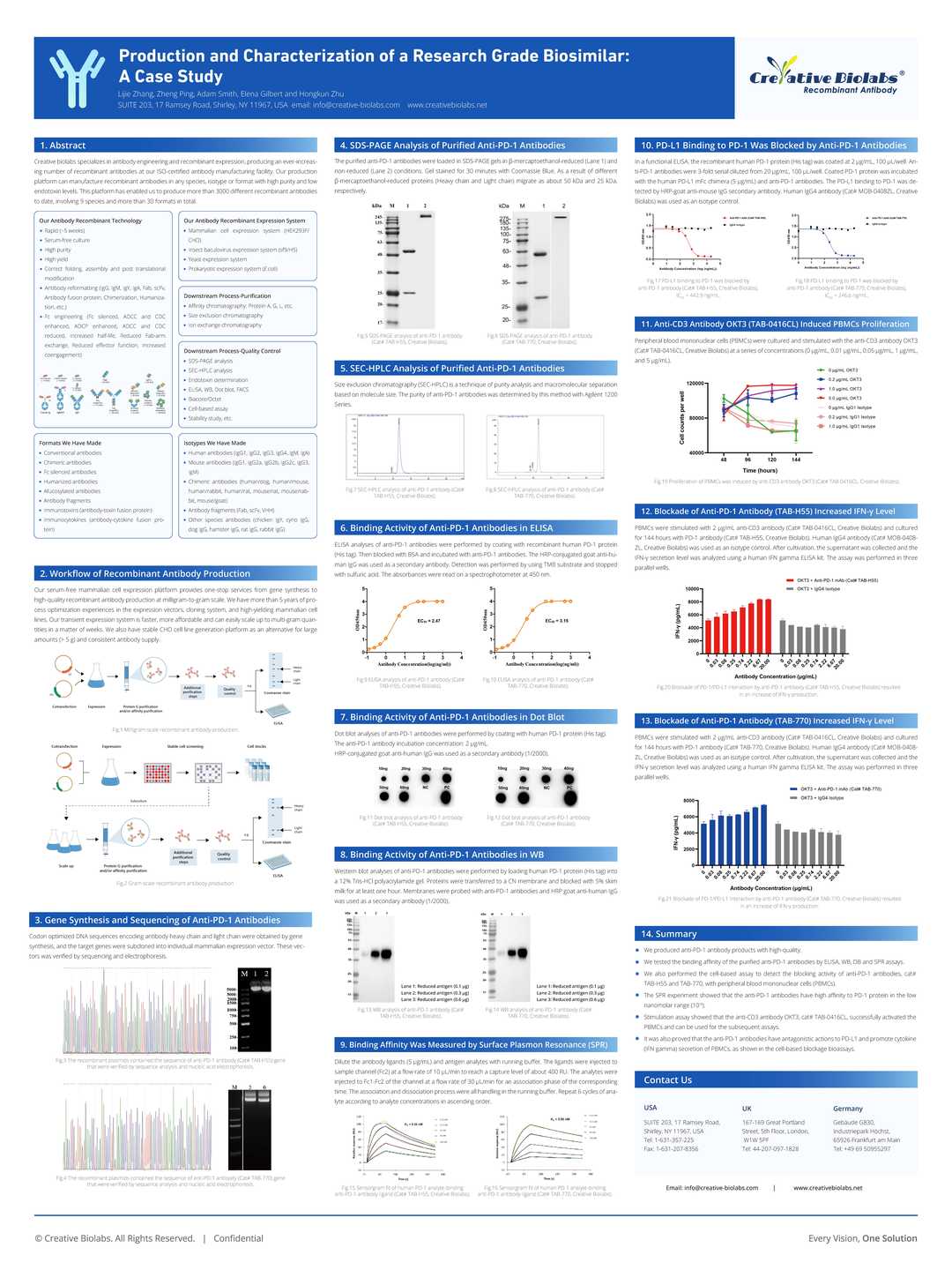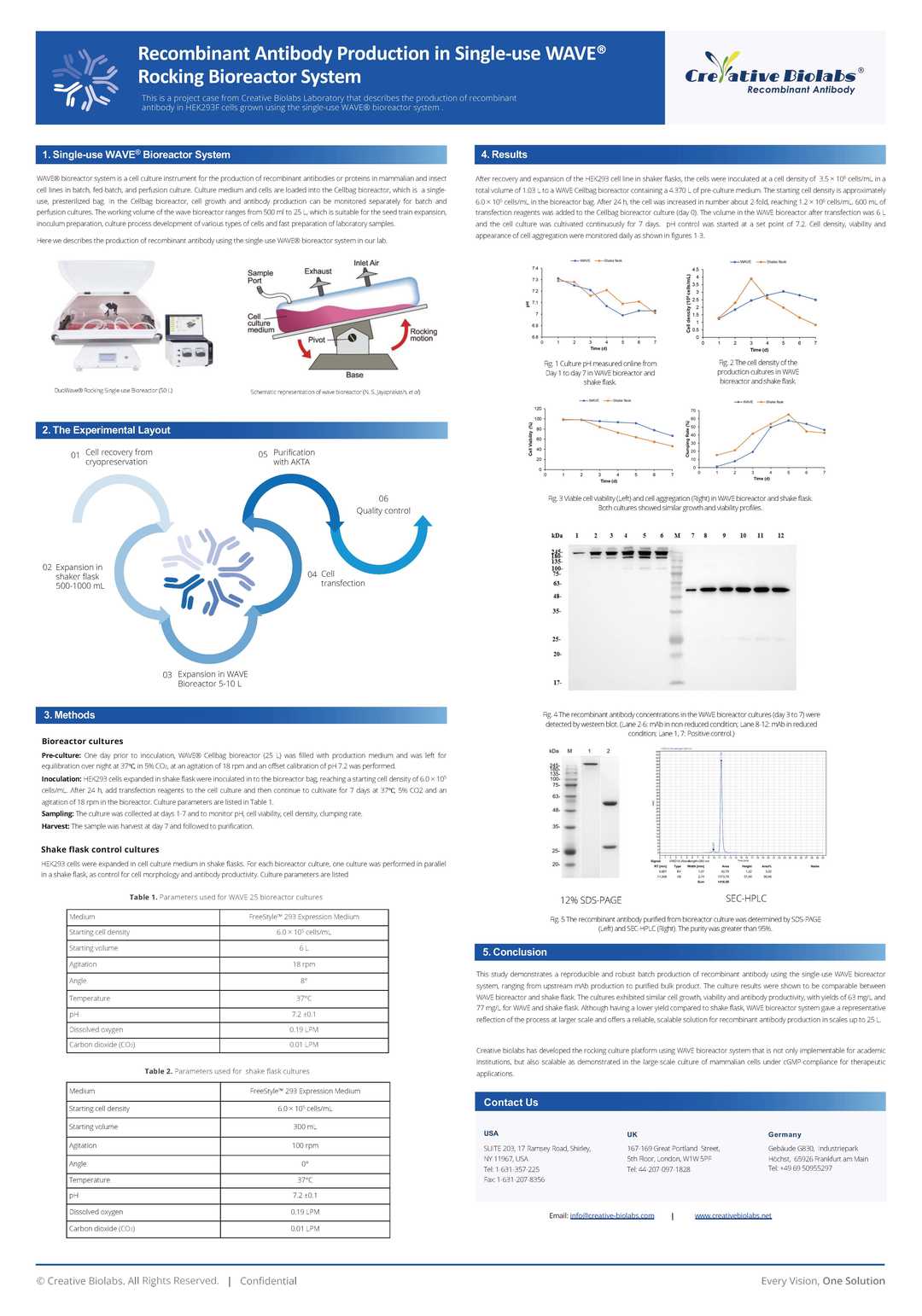Chimeric (Mouse/Human) Anti-SDC1 Recombinant Antibody (TAB-197)
CAT#: TAB-197
This product is a Chimeric (mouse/human) IgG4, κ antibody that can recognize human SDC1.









Specifications
- Immunogen
- U266 cell line
- Host Species
- Human
- Derivation
- Chimeric (mouse/Human)
- Type
- Chimeric (mouse/Human) IgG4, κ
- Specificity
- Human SDC1
- Species Reactivity
- Human
- Applications
- Neut, ELISA, IF, IP, FuncS, FC, ICC
Product Property
- Purification
- Protein A/G Purified
- Purity
- >95% as determined by SDS-PAGE and HPLC analysis
- Concentration
- Please refer to the vial label for the specific concentration
- Buffer
- PBS
- Preservative
- No preservatives
- Storage
- Centrifuge briefly prior to opening vial. Store at +4°C short term (1-2 weeks). Aliquot and store at -20°C long term. Avoid repeated freeze/thaw cycles.
Applications
- Application Notes
- This antibody has been reported for use in Neutralization, Enzyme-linked Immunosorbent Assay, Immunofluorescence, Immunoprecipitation, Functional Assay, Flow Cytometry, Immunocytochemistry.
Target
Customer Review
There are currently no Customer reviews or questions for TAB-197. Click the button above to contact us or submit your feedback about this product.


Q&As
-
What is the isotype of this chimeric antibody?
A: This Anti-SDC1 Recombinant Antibody (TAB-197) is a Chimeric (mouse/human) IgG4, kappa antibody. It combines mouse variable regions with human constant regions and is validated for a wide range of applications including IP, IF, FC, and FuncS.
-
Does this antibody recognize human SDC1?
A: Yes, this antibody specifically recognizes Human SDC1 (Syndecan-1). It was raised against the U266 cell line and has been extensively tested in ELISA, Neutralization, and other immunological methods.
View the frequently asked questions answered by Creative Biolabs Support.
Cite This Product
To accurately reference this product in your publication, please use the following citation information:
(Creative Biolabs Cat# TAB-197, RRID: AB_3111866)
Submit Your Publication
Published with our product? Submit your paper and receive a 10% discount on your next order! Share your research to earn exclusive rewards.
Biosimilar Overview
Please refer to Indatuximab Ravtansine Overview to learn more about the mechanism of action, clinical projects, and approved drugs of Indatuximab Ravtansine.
Downloadable Resources
Download resources about recombinant antibody development and antibody engineering to boost your research.
Product Notes
This is a product of Creative Biolabs' Hi-Affi™ recombinant antibody portfolio, which has several benefits including:
• Increased sensitivity
• Confirmed specificity
• High repeatability
• Excellent batch-to-batch consistency
• Sustainable supply
• Animal-free production
See more details about Hi-Affi™ recombinant antibody benefits.
Datasheet
MSDS
COA
Certificate of Analysis LookupTo download a Certificate of Analysis, please enter a lot number in the search box below. Note: Certificate of Analysis not available for kit components.
Protocol & Troubleshooting
We have outlined the assay protocols, covering reagents, solutions, procedures, and troubleshooting tips for common issues in order to better assist clients in conducting experiments with our products. View the full list of Protocol & Troubleshooting.
See other products for "SDC1"
Select a product category from the dropdown menu below to view related products.
| CAT | Product Name | Application | Type |
|---|---|---|---|
| MOB-2506z | Mouse Anti-SDC1 Recombinant Antibody (clone 22B3) | WB, ELISA, FC, ICC | Mouse IgG1 |
| CAT | Product Name | Application | Type |
|---|---|---|---|
| TAB-495CT | Mouse Anti-SDC1 Recombinant Antibody (TAB-495CT) | FC, WB | Mouse IgG1, κ |
| CAT | Product Name | Application | Type |
|---|---|---|---|
| TAB-495CT-S(P) | Mouse Anti-SDC1 Recombinant Antibody; scFv Fragment (TAB-495CT-S(P)) | FC, WB | Mouse scFv |
| CAT | Product Name | Application | Type |
|---|---|---|---|
| TAB-495CT-F(E) | Mouse Anti-SDC1 Recombinant Antibody; Fab Fragment (TAB-495CT-F(E)) | FC, WB | Mouse Fab |
| CAT | Product Name | Application | Type |
|---|---|---|---|
| MOB-0294MZ | Recombinant Mouse Anti-Human Syndecan 1 Antibody (clone NI16) | IHC | Mouse antibody |
| CAT | Product Name | Application | Type |
|---|---|---|---|
| MOR-3189 | Hi-Affi™ Recombinant Rabbit Anti-SDC1 Monoclonal Antibody (DS3189AB) | IHC-P | IgG |
| CAT | Product Name | Application | Type |
|---|---|---|---|
| HPAB-0324-CN | Human Anti-SDC1 Recombinant Antibody (HPAB-0324-CN) | ELISA, FC | Humanized IgG3, κ |
| CAT | Product Name | Application | Type |
|---|---|---|---|
| HPAB-0326-CN | Human Anti-SDC1 Recombinant Antibody (HPAB-0326-CN) | ELISA, FC | Humanized IgG4, κ |
| CAT | Product Name | Application | Type |
|---|---|---|---|
| HPAB-0324-CN-S(P) | Human Anti-SDC1 Recombinant Antibody; scFv Fragment (HPAB-0324-CN-S(P)) | ELISA, FC | Human scFv |
| CAT | Product Name | Application | Type |
|---|---|---|---|
| HPAB-0326-CN-S(P) | Human Anti-SDC1 Recombinant Antibody; scFv Fragment (HPAB-0326-CN-S(P)) | ELISA, FC | Human scFv |
| CAT | Product Name | Application | Type |
|---|---|---|---|
| HPAB-0324-CN-F(E) | Human Anti-SDC1 Recombinant Antibody; Fab Fragment (HPAB-0324-CN-F(E)) | ELISA, FC | Humanized Fab |
| CAT | Product Name | Application | Type |
|---|---|---|---|
| HPAB-0326-CN-F(E) | Human Anti-SDC1 Recombinant Antibody; Fab Fragment (HPAB-0326-CN-F(E)) | ELISA, FC | Humanized Fab |
| CAT | Product Name | Application | Type |
|---|---|---|---|
| NS-086CN | Human Anti-SDC1 Recombinant Antibody (NS-086CN) | ELISA | Humanized IgG |
| CAT | Product Name | Application | Type |
|---|---|---|---|
| NS-087CN | Human Anti-SDC1 Recombinant Antibody (NS-087CN) | ELISA | Humanized IgG |
| CAT | Product Name | Application | Type |
|---|---|---|---|
| NS-086CN-F(E) | Human Anti-SDC1 Recombinant Antibody; Fab Fragment (NS-086CN-F(E)) | ELISA | Humanized Fab |
| CAT | Product Name | Application | Type |
|---|---|---|---|
| NS-087CN-F(E) | Human Anti-SDC1 Recombinant Antibody; Fab Fragment (NS-087CN-F(E)) | ELISA | Humanized Fab |
| CAT | Product Name | Application | Type |
|---|---|---|---|
| NS-086CN-S(P) | Human Anti-SDC1 Recombinant Antibody; scFv Fragment (NS-086CN-S(P)) | ELISA | Human scFv |
| CAT | Product Name | Application | Type |
|---|---|---|---|
| NS-089CN | Mouse Anti-SDC1 Recombinant Antibody (NS-089CN) | ELISA | Mouse IgG |
| CAT | Product Name | Application | Type |
|---|---|---|---|
| AFC-TAB-197 | Afuco™ Anti-SDC1 ADCC Recombinant Antibody, ADCC Enhanced (AFC-TAB-197) | Neut, ELISA, IF, IP, FuncS, FC | ADCC enhanced antibody |
| CAT | Product Name | Application | Type |
|---|---|---|---|
| HPAB-2546LY-F(E) | Human Anti-SDC1 Recombinant Antibody; Fab Fragment (HPAB-2546LY-F(E)) | ELISA | Humanized Fab |
| CAT | Product Name | Application | Type |
|---|---|---|---|
| HPAB-2546LY-S(P) | Human Anti-SDC1 Recombinant Antibody; scFv Fragment (HPAB-2546LY-S(P)) | ELISA | Human scFv |
| CAT | Product Name | Application | Type |
|---|---|---|---|
| VS3-QX1001 | Mouse Anti-SDC1 Recombinant Antibody (clone 587CT7.3.6.5) | WB, ICC, FC | Mouse IgM |
| CAT | Product Name | Application | Type |
|---|---|---|---|
| VS-0225-XY193 | CytoStream™ Mouse Anti-SDC1 Recombinant Antibody (VS-0225-XY193) | FC | Mouse IgG1, kappa |
| CAT | Product Name | Application | Type |
|---|---|---|---|
| VS-0325-FY16 | Human Anti-SDC1 scFv-Fc Chimera (VS-0325-FY16) | ELISA, FC, Cyt | Human IgG1, scFv-Fc |
| CAT | Product Name | Application | Type |
|---|---|---|---|
| VS-0325-FY153 | Human Anti-SDC1 scFv-Fc Chimera (VS-0325-FY153) | ADCC | Human IgG1, scFv-Fc |
| CAT | Product Name | Application | Type |
|---|---|---|---|
| VS13-YC1044 | CytoStream™ Rabbit Anti-SDC1 Recombinant Antibody (VS13-YC1044) | WB, IHC-P, ICC, IF, FC | Rabbit IgG |
| CAT | Product Name | Application | Type |
|---|---|---|---|
| VS-0425-YC134 | Recombinant Anti-SDC1 Vesicular Antibody, EV Displayed (VS-0425-YC134) | ELISA, FC, Cell-uptake |
| CAT | Product Name | Application | Type |
|---|---|---|---|
| VS-0525-XY6401 | Anti-SDC1 Immunohistochemistry Kit | IHC |
| CAT | Product Name | Application | Type |
|---|---|---|---|
| VS-0525-XY6402 | Anti-Mouse SDC1 Immunohistochemistry Kit | IHC |
| CAT | Product Name | Application | Type |
|---|---|---|---|
| VS-0525-XY6404 | Anti-Rat SDC1 Immunohistochemistry Kit | IHC |
| CAT | Product Name | Application | Type |
|---|---|---|---|
| VS-0825-YC300 | SmartAb™ Recombinant Anti-SDC1 pH-dependent Antibody (VS-0825-YC300) | ELISA, FC | Human IgG3 kappa |
Popular Products

Application: FC, IP, ELISA, Neut, FuncS, IF, IHC

Application: IP, IF, FuncS, FC, Neut, ELISA, ICC

Application: ELISA, FC, IP, FuncS, IF, Neut, WB

Application: WB, ELISA, FuncS

Application: WB, ELISA, FuncS
-2.png)
Application: IB, ELISA, FC, FuncS

Application: IHC, ELISA, FC, WB, ADCC, FuncS

Application: FC, FRET, Internalization

Application: WB, ELISA, FuncS, Inhib, PK, IP, SPR
-4.jpg)
Application: FC, FuncS, IA, IF, IP, IHC

Application: ELISA, FC, WB, Inhib, IHC
For research use only. Not intended for any clinical use. No products from Creative Biolabs may be resold, modified for resale or used to manufacture commercial products without prior written approval from Creative Biolabs.
This site is protected by reCAPTCHA and the Google Privacy Policy and Terms of Service apply.





















-3.jpg)



